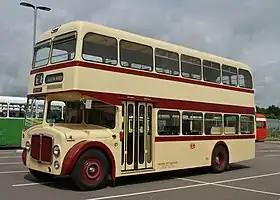| AEC Renown | |
|---|---|
 1965 AEC Renown (reg. DBC 190C), in Leicestre Corporation Transport livery. | |
| Overview | |
| Manufacturer | AEC |
| Production | 1962-1967 |
| Body and chassis | |
| Doors | Front, behind front axle |
| Floor type | Lowbridge |
| Powertrain | |
| Engine | AEC AV590 |
| Transmission | AEC synchromesh AEC Monocontrol |
| Chronology | |
| Predecessor | AEC Bridgemaster |
The AEC Renown was a front-engined low-height double-decker bus chassis manufactured by AEC. It superseded the AEC Bridgemaster around 1962.[1]
History

The low-height double-decker AEC Bridgemaster was nearing the end of its production when AEC launched the Renown as its successor around 1962, not long before the acquisition of AEC by Leyland. The main difference between the Renown and its predecessor was the chassis design, the Renown was designed as a complete chassis, rather than integral construction adopted by the Bridgemaster, thus the Renown could be suited to different body designs.[3] The engine was the AEC AV590, as used in the Bridgemaster, which had a displacement of 590 in3 (9.7 L) and developed 128 bhp (95 kW) at 1,800 rpm. The transmission could either be the AEC "Monocontrol" semi-automatic three-speed epicyclic gearbox, or a clutch and four-speed synchromesh gearbox. Two prototypes were built in 1962, one for each transmission option; the monocontrol example (model 3B2RA) was tried out by London Transport, and the synchromesh example (model 3B3RA) was initially exhibited at the Commercial Motor Show, and then used by AEC as a demonstrator. In the model codes, the initial 3B indicated a Renown (the Bridgemaster having been B or 2B); the next figure showed the number of pedals and thus the type of transmission – the Monocontrol option had no clutch pedal; the R denoted right-hand drive; and the A denoted air brakes.[4]
The design, like the Bristol Lodekka and the Dennis Loline meant this double-decker could travel under low height bridges, whilst maintaining near-full-height standing room.
Bodywork was constructed by a variety of coachbuilders, primarily Park Royal Vehicles which built 130, but also included: East Lancs (33); Northern Counties (39); and Weymann (40). Most had the entrances situated just behind the front axle, but fourteen of those built by East Lancs had rear entrances. Major customers included City of Oxford Motor Services (43); East Yorkshire Motor Services (34); North Western Road Car Company (33); Nottingham City Transport (42); and Western Welsh (28). Virtually all customers specified the synchromesh transmission – only five (including one of the prototypes) were built with the Monocontrol transmission.[4]
After Leyland acquired a 25% stake of Bristol Commercial Vehicles and Eastern Coach Works in late 1965, Leyland had three different front-engined low-height double-deck designs: AEC Renown, Bristol Lodekka and Albion Lowlander. Leyland quickly decided to cease taking orders for the Renown and Lowlander. The last AEC Renown was delivered in 1967, [3] with a total of 251 buses built.
References
- ↑ Era ends Commercial Motor 19 November 1976
- ↑ A.E.C. Limited AEC Renown brochure No. 719.7.62
- 1 2 Ward, Rod (2018). AEC album : part two : after 1945 plus the Maudslay story. Zeteo Publishing. p. 20. OCLC 1082957062.
- 1 2 Jolly, Stephen; Wareham, Grahame (1980). AEC Renown. Yarnton: Oxford Bus Preservation Syndicate. ISBN 0-9506739-1-9.
- Brown, Stuart J (2013). The Lodekka Alternatives. Hersham: Ian Allan Publishing.